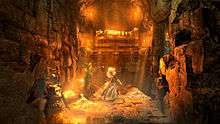Loot (video games)
In video games, loot describes valuable items picked up by the player character over the course of the game, such as in-game currency, spells, equipment and weapons. In single-player games, it is often obtained as treasure or looted from defeated enemies,[1] and loot is considered distinct from items purchased from in-game shops.

Loot is meant to reward the player for progressing in the game, and can be of superior quality to items that can be purchased. It can also be part of an upgrade system that permanently increases the player's abilities.[1]
In multiplayer games, loot may be provided in such a manner that only one player may acquire any given item. "Ninja-looting" is the resulting practice of looting items off enemies defeated by other players.[2] Players may choose to employ a loot system to distribute their spoils. In a PVP situation, loot may be taken from a defeated player.[2]
In role-playing video games, loot often forms the core economy of the game, in which the player fights to obtain loot and then uses it to purchase other items.[3] Loot may often be assigned to tiers of rarity, with the rarer items being more powerful and more difficult to obtain. The various tiers of rarity are often indicated by particular colors that allow a player to quickly recognize the quality of their loot. The concept of color-coded loot rarity was popularized with the 1996 game Diablo, whose designer, David Brevik, took the idea from the roguelike video game Angband.[4]
Loot boxes
Loot boxes are a particular type of randomized loot system that consists of boxes that can be unlocked through normal play, or by purchasing more via microtransaction. The system has garnered a great deal of controversy for being too similar to gambling.
References
- Rogers, Scott (2014). Level up! : the guide to great video game design (2nd ed.). Hoboken: Wiley. p. 399. ISBN 9781118877210. OCLC 877770975.
- "'City of Heroes' is a massively entertaining online success". Milwaukee Journal Sentinel. August 31, 2004. p. 3E. Retrieved Jan 31, 2010.
- Sellers, Michael (2017). Advanced game design : a systems approach. Boston. ISBN 9780134668185. OCLC 1012108932.
- Hanson, Ben (16 May 2019). "GI Show – Rage 2, Final Fantasy VII, David Brevik Interview". Game Informer. At 2:37:05. Retrieved 19 May 2019.CS1 maint: location (link)